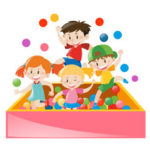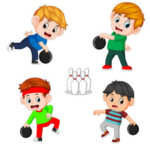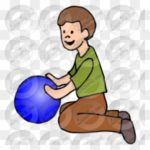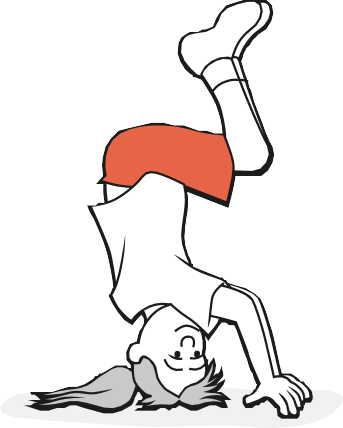
by Santosh | Jun 10, 2020 | Fitness Activity
Movement skills/concepts
Inverted static balance, body and space awareness.
Set-up
Wall, chairs, safety mats.
Mats are scattered in a defined area, with children sharing each mat.
Activity
Shoulder stand: Start in a crouched position with fingers touching the mat. Rock back so your bottom, then back, then shoulders touch the floor. Support your weight by bending your arms at the elbows and supporting your hips with your hands. Hold for 3 seconds and then slowly roll back into a crouched position.

Tripod balance: Start in a crouched position, make a triangle with your hands and head, and walk one knee and then the other onto your elbows. Weight is on the crown of your head, not your forehead. ‘Squeeze’ your fingers.
Handstand: Stand with your back against a wall. Beginning in a squat position, place your hands flat on the mat, keeping your arms straight. Walk up the wall then down, keeping a tight body.
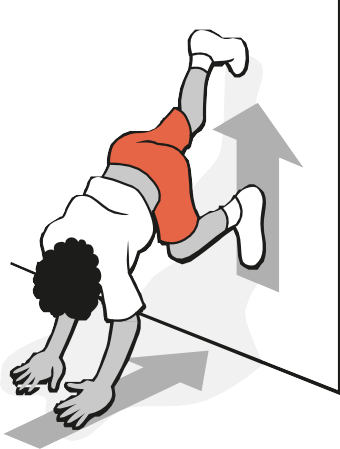
Kick ups: Face the wall, one foot in front of the other (front–back stance). Lean forward and place your hands down on the mat, shoulder width apart and fingers pointing forwards. Using your back leg as a lever, kick your leg upward so that the weight is supported by your arms. Come down safely by twisting your trunk slightly to bring feet down in a new place.
Can you see …?
- wide base of support
- tight body
- control when engaging and disengaging
- support where needed
You could ask …
What do you need to do to balance in an inverted position?
What are some ways you can safely come out of a balance? Show me.
Variations
Inverted balance on equipment: Do a shoulder stand between two chairs. Make sure that the chairs are stable, and that support is available.
COOL DOWN/ CLOSURE
Review Skill/Activity, stretching, and questions.
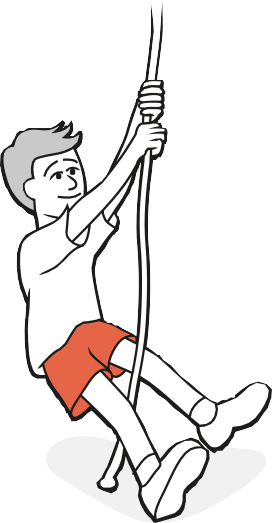
by Santosh | Jun 10, 2020 | Fitness Activity
Movement skills/concepts
Dynamic balance, climbing on equipment at varying heights, angles and spaces.
Set-up
Ropes, ladders, bars, poles, climbing net. Available playground/gymnastic equipment. Individuals or small groups start at different points of a circuit.
Activity
Horizontal ladders: Children move along on all fours, facing downwards and upwards.
Jungle gym and similar equipment: Mark a course on the equipment with numbered tags to follow either in a set order or in any order.
Inclined equipment: Children follow a circuit of ladders, nets, benches, parallel pipes, etc. They then try it in reverse order or help an ‘injured’ partner around.
Vertical ladders/wall bars: Children climb up and down, climb up, across/through and down.
Low, horizontal rope: With a rope over a slippery surface, children lie on their back and pull along with a hand-over-hand action.
Vertical ropes: From sitting on the floor, children pull up hand over hand to standing, then lower hand over hand to sitting.
Combination climbs: Set up an obstacle course using ropes, ladders, bars, nets, beams, boxes, outdoor equipment, etc. Climb this in different ways.
Can you see …?
- alternate, independent foot and leg action
- safe surface for hands
- frequent breaks from walking on the hands
- creative play – children exploring and discovering equipment
You could ask …
How do you adjust your climbing action when climbing up a rope compared to climbing on a fixed structure?
What was the most difficult equipment to climb? Why was this?
COOL DOWN/ CLOSURE
Review Skill/Activity, stretching, and questions.

by Santosh | Jun 10, 2020 | Fitness Activity
Movement skills/concepts
Static balance, counterbalance, body and space awareness, problem solving and relationships (with others).
Set-up
Benches, box tops, mats and balls.
Children are in pairs of approximately the same height and size. Each pair has a mat or a defined area to work in.
Activity
With a partner, explore how many ways you can balance. Repeat with only one base of support for each partner.
Repeat one more time, this time without using your foot as a base of support (e.g. using back or hands).
Can you balance with your partner – on a line, bench/box top, or crash pad with only …?
- two feet on the ground
- two hands and one foot
- one foot and two knees
- one back and one foot
With your partner, can you be the shape of …?
- an apple tree
- a yacht
- a letter of the alphabet – try A, D, G, J, P, U – or a number
Can you perform the ‘dead bug carry’? One partner kneels on all fours and the other lies on their back on top. The person underneath then moves around.
Create a sequence of balances, moving smoothly from one balance to another. In groups of 3 or 5, create a pyramid
Can you see …?
- counterbalance
- wide base of support
- slow control when engaging and disengaging
- pairs matched for height and weight
You could ask …
What do you need to do to balance with your partner safely and under control? How can you and your partner counterbalance?
Variations
Vary equipment: Balance in pairs using a ball or rope.
Mirror image balances: In pairs, each partner mirrors the other’s shape.
COOL DOWN/ CLOSURE
Review Skill/Activity, stretching, and questions.
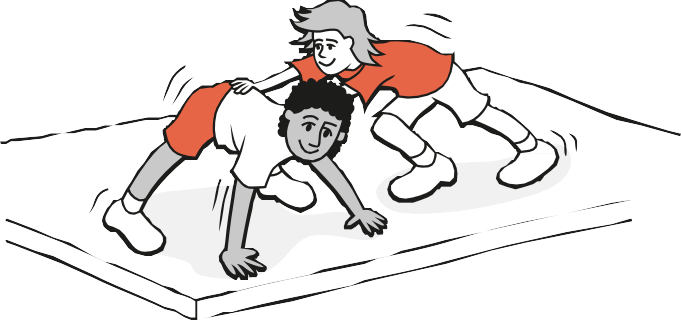
by Santosh | Jun 10, 2020 | Fitness Activity
Movement skills/concepts
Static balance, body and space awareness.
Set-up
Mats.
Children in pairs or groups of three, with a mat per pair/group on a hard, even surface.
Activity
The object of this activity is to maintain a tight body position in each stance.
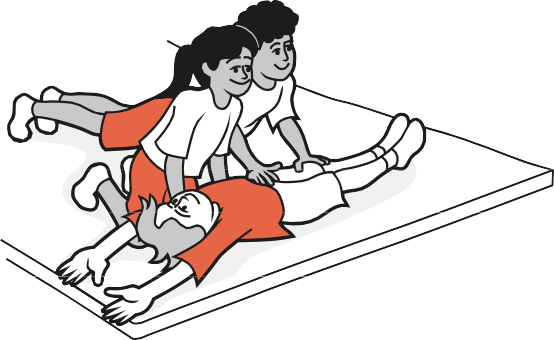
Immovable rock: One child (the rock) lies on their back on the mat with a straight body, arms above head. Two partners try to roll the rock over, while the rock resists by keeping a tight body. Switch roles and repeat.

Tip the spider: In pairs, one child (the spider) is on all fours forming a stable bridge. The partner attempts to tip over the spider. Switch roles and repeat.
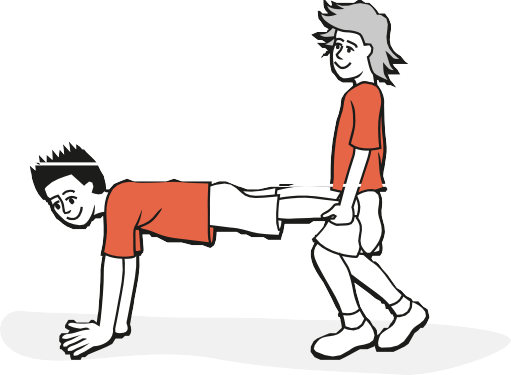
Wheelbarrow lift: In pairs, one child is the wheelbarrow who is in a tight front support position. Their partner should grasp the wheelbarrow’s legs around the knee joint and lift no higher than their own thighs (approximately 50 cm).
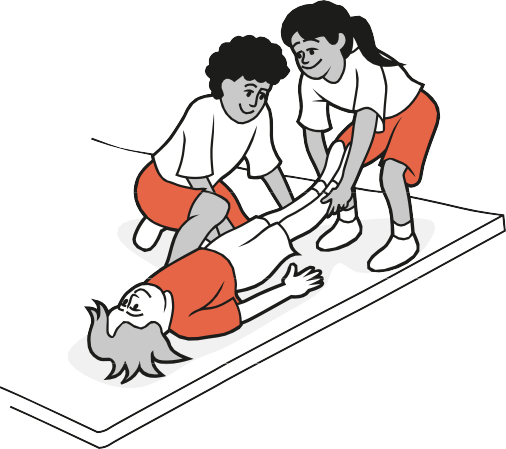
Lift the plank: In groups of three, one child (the plank) lies on their back on the floor with a tight straight body and arms by their side. Partners try to lift the plank no higher than knee height.
Can you see …?
- tight muscles
- lifting with knees and straight back
You could ask …
How do you lift safely without hurting your back? To keep a straight body, what do you need to do?
Variations
Standing immovable rock: In pairs, children take turns at standing in an upright, stable position – partners try to push them over.
COOL DOWN/ CLOSURE
Review Skill/Activity, stretching, and questions.

by Santosh | Jun 10, 2020 | Fitness Activity
Movement skills/concepts
Static balance, balancing on different body parts, problem solving, body and space awareness.
Set-up
Mats.
Even surface in a defined hard or grass surface area.
Prepare a set of small cards with two or more symbols on each card, chosen so that it is possible to achieve a balance from that combination. Below are some ideas for symbols that could be used.
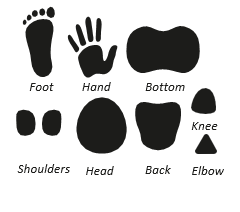
Examples of cards and balance
- two feet and two elbows head, two hands and two feet
- bottom and two hands one knee and one foot
Activity
Children take a sheet with a series of puzzle balances and see how many balances they can do to solve the puzzle, using mats provided.
Can you see …?
- head up – focused on object
- stillness
- tight muscles
- avoidance of activities that put pressure on neck
You could ask …
What do you need to do with the body parts that are not part of your base of support? What do you need to do to maintain your balance?
Variations
Create a sequence: Move from puzzle balance to puzzle balance to create a sequence.
Work in pairs or small groups: Group members instruct each other (verbally) about how to do the puzzle balances.
COOL DOWN/ CLOSURE
Review Skill/Activity, stretching, and questions.
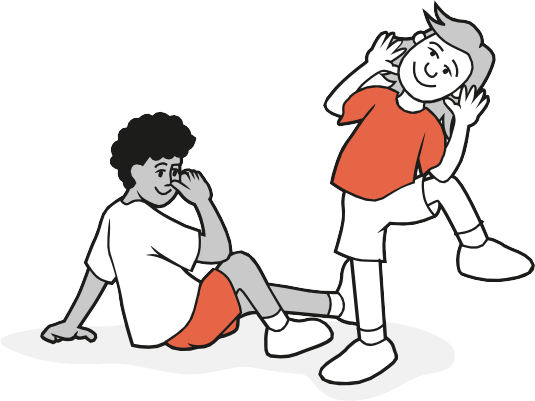
by Santosh | Jun 10, 2020 | Fitness Activity
Movement skills/concepts
Static and dynamic balance, body awareness, space awareness and relationships (with others).
Set-up
Children are spread out in a defined area on a hard or grass surface.
Activity 1: Connecting yourself
Children walk freely about the area. On a signal, they stop and listen to the coach/ teacher calling out two body parts, which each child then has to join together.
Examples: elbow to knee, hand to foot, foot to foot, hand to shoulder, head to hand, knee to ankle, foot to head.
Activity 2: Connecting in pairs
In pairs, children travel around the area in a designated way (e.g. walking or skipping) while joined together (linking arms). On a signal, the pairs connect to each other by the body parts called by the coach/teacher. Examples: two feet (one foot from each partner in the pair), two hands, one foot, and one knee, one shoulder and one head, one elbow and one hip, one ankle, and one knee.
Can you see …?
- head up – focused on an object or spot
- tight muscles
You could ask …?
What do you need to do with your body to maintain your balance? How can you and your partner work together to maintain your balance?
Variations
Vary the way of traveling around in space: Use different dynamic balance activities, (e.g. kangaroo walk, crazy crab, monkey walk).
Vary body shapes and levels: Include narrow/wide-body shapes and low/medium/ tall levels.
COOL DOWN/ CLOSURE
Review Skill/Activity, stretching, and questions.














